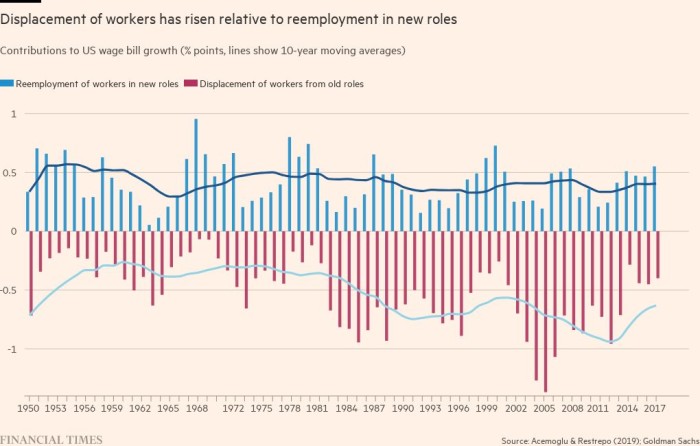In 1900, the UK had 3.3 million horses. These animals provided traction, transport, and cavalry. Today, only playtime is left. Horses are an outdated technology. Their number in the UK has fallen by around 75%. Could humans also become an antiquated technology, replaced by machines that are not only stronger and more skilled, but also smarter, even more creative? The threat, we are told, is remote. Yet this is a matter of faith. Perhaps machines could do much of what we need to do better than we do, with the exception of being human and caring the way humans do.
Yet even if no such revolution threatens, recent advances in artificial intelligence are very significant. Second Bill Doors, are the most important development since personal computers. So what could the implications be? Can we check them?
The natural place to start is with work and productivity. An article by David Autor of MIT and co-authors it provides a useful analytical framework and sobering conclusions about what happened in the past. It distinguishes innovation that increases work from that which automates work. He concludes that “most of current employment is in new job specialties introduced after 1940”. But the locus of this new work has shifted from mid-wage manufacturing and clerical occupations before 1980 to high-wage and secondarily low-wage professional services thereafter. Thus, innovation has increasingly emptied middle-income jobs.

Furthermore, innovations generate new types of jobs only when they complement jobs, not when they replace them. Finally, the demand-eroding effects of automation have intensified over the past four decades, while the demand-enhancing effects of augmentation have not. None of this is encouraging, especially since overall productivity growth has been quite modest since 1980.

So what about the future? On this, an analysis by Goldman Sachs is both optimistic and reassuring. He argues that “the combination of significant labor cost savings, new job creation and increased productivity for non-displaced workers raises the possibility of a labor productivity boom.” This would be similar to what eventually followed with the emergence of the electric motor and the personal computer. The study estimates that generative AI, in particular, could boost annual labor productivity growth in the United States by 1.5 percentage points. The increase would be greater in high-income countries than in developing ones, although times are uncertain.
Globally, he suggests, 18% of work could be automated by AI, again with the greatest effects in high-income countries. In the case of the United States, the estimated share of work exposed to AI varies between 15 and 35%. The most vulnerable jobs will be office and administration, legal, architecture and engineering. The least exposed will be in construction, installation and maintenance. Socially, the impact will fall more on relatively well-educated white-collar workers. The danger is therefore the downward mobility of the middle and upper middle classes. The social and political impact of such changes appears all too evident, even if the overall effect is actually to increase productivity. Unlike horses, people won’t disappear. They also have grades.
Yet these economic effects are a far cry from the whole story. AI is a much bigger change than that. It raises profound questions about who and what we are. It may be the most transformative technology of all for our sense of self.

Let us consider some of these broader effects. Yes, we could have incorruptible, rational judges and better science. But we may also have a world of perfectly false information, images and identities. We could have more powerful monopolies and plutocrats. We may have almost complete surveillance by governments and companies. We could have a much more effective manipulation of the democratic political process. Yuval Harari he claims that “democracy is a conversation and conversations are based on language. When AI hacks into language, it could destroy our ability to have meaningful conversations, thus destroying democracy.” Daron Acemoglu of MIT argues that we need to understand those harms before freeing the AI. Geoffrey Hintona “godfather” of AI, he even decided to step down from Google.
The problem with regulating AI, however, is that unlike, say, drugs, which have a known target (the human body) and known targets (a cure of some kind), AI is a technology of general. It is multipurpose. It can change economies, national competitiveness, relative power, social relations, politics, education and science. It can change the way we think and create, perhaps even how we understand our place in the world.
We cannot hope to achieve all these effects. They are too complex. It would be like trying to understand the effect of printing in the fifteenth century. We cannot hope to agree on what is to be favored and what is to be prevented. And even if some countries did, we would never stop the others. In 1433, the Chinese Empire halted attempts to project naval power. That didn’t stop others from doing it, ultimately defeating China.
Humanity is Doctor Faust. It too seeks knowledge and power and is ready to make almost any deal to obtain it, regardless of the consequences. Even worse, he’s a kind of competing Doctor Faustus, seeking knowledge and power, as he did. We have experienced the impact of the social media revolution about our society and politics. Some warn of its consequences for our children. But we can’t stop the deals we’ve made. We will not stop this revolution either. We are Faust. We are Mephistopheles. The AI revolution will go on.
—————————————————-
Source link


